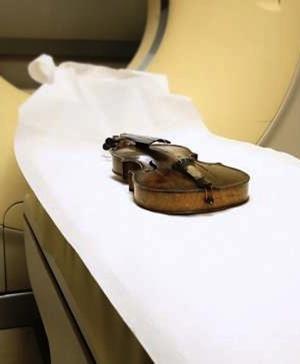
A violin thought to have been played during the sinking of the
RMS Titanic has undergone a hospital CT scan to determine its age
and condition. The research, commissioned by auctioneers Henry
Aldridge & Son, showed that the instrument had been damaged and
restored.
Radiographer Astrid Little of the BMI Ridgeway Hospital in Swindon,
UK, said: ‘The scan revealed that the original wood was cracked and
showed signs of possible restoration.’ The construction, interior
and glue used to hold the violin together was also examined.
Neither Little nor the auctioneer, Andrew Aldridge, was available
for further comment.
In March, the violin was presented as genuine by the auctioneers
after an examination by Bath-based dealer Andrew Hooker. He
estimated its date as between 1880 and 1900: based on a Maggini
model, it was probably made in a German factory, possibly in
Markneukirchen or Klingenthal. It has a spruce front and maple
back. No maker’s label has survived, although the violin bears a
silver plate on the tailpiece, with the inscription: ‘For Wallace
on the occasion of our engagement from Maria.’
The evidence unearthed by the auctioneers appears to show that
Hartley put the violin inside a leather Gladstone-type bag, which
he then strapped to his body before the ship sank. Forensic
analysis showed some evidence of salt-water corrosion, and the
metal screws on the tailpiece’s silver plate appeared to have been
exposed to sea water over time.
Photo: courtesy BMI Ridgeway Hospital,
Swindon
































No comments yet